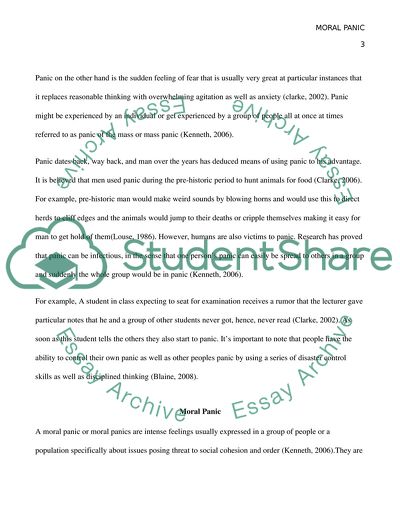Cite this document
(What do you understand by the phrase 'moral panic' Please Coursework - 1, n.d.)
What do you understand by the phrase 'moral panic' Please Coursework - 1. Retrieved from https://studentshare.org/psychology/1686819-what-do-you-understand-by-the-phrase-aposmoral-panicapos-please-refer-to-at-least-one-contemporary-example-which-illustrates-how-the-media-can-be-said-to-be-responsible-for-creating-moral-panics
What do you understand by the phrase 'moral panic' Please Coursework - 1. Retrieved from https://studentshare.org/psychology/1686819-what-do-you-understand-by-the-phrase-aposmoral-panicapos-please-refer-to-at-least-one-contemporary-example-which-illustrates-how-the-media-can-be-said-to-be-responsible-for-creating-moral-panics
(What Do You Understand by the Phrase 'Moral panic' Please Coursework - 1)
What Do You Understand by the Phrase 'Moral panic' Please Coursework - 1. https://studentshare.org/psychology/1686819-what-do-you-understand-by-the-phrase-aposmoral-panicapos-please-refer-to-at-least-one-contemporary-example-which-illustrates-how-the-media-can-be-said-to-be-responsible-for-creating-moral-panics.
What Do You Understand by the Phrase 'Moral panic' Please Coursework - 1. https://studentshare.org/psychology/1686819-what-do-you-understand-by-the-phrase-aposmoral-panicapos-please-refer-to-at-least-one-contemporary-example-which-illustrates-how-the-media-can-be-said-to-be-responsible-for-creating-moral-panics.
“What Do You Understand by the Phrase 'Moral panic' Please Coursework - 1”, n.d. https://studentshare.org/psychology/1686819-what-do-you-understand-by-the-phrase-aposmoral-panicapos-please-refer-to-at-least-one-contemporary-example-which-illustrates-how-the-media-can-be-said-to-be-responsible-for-creating-moral-panics.


